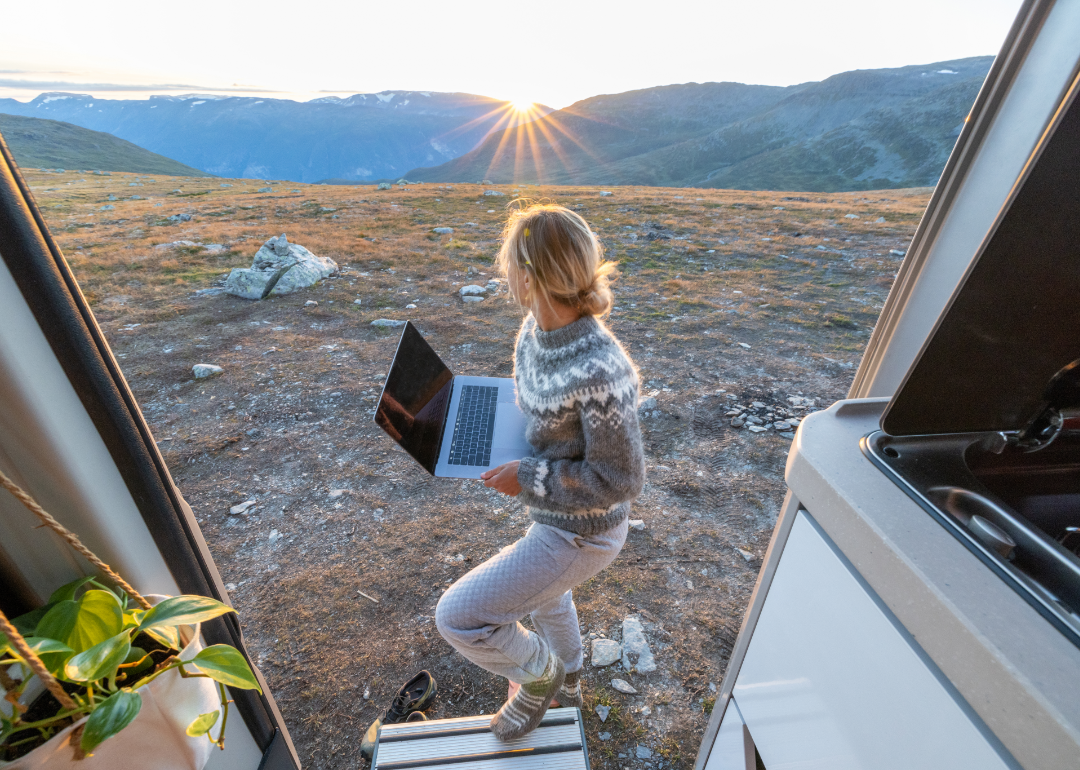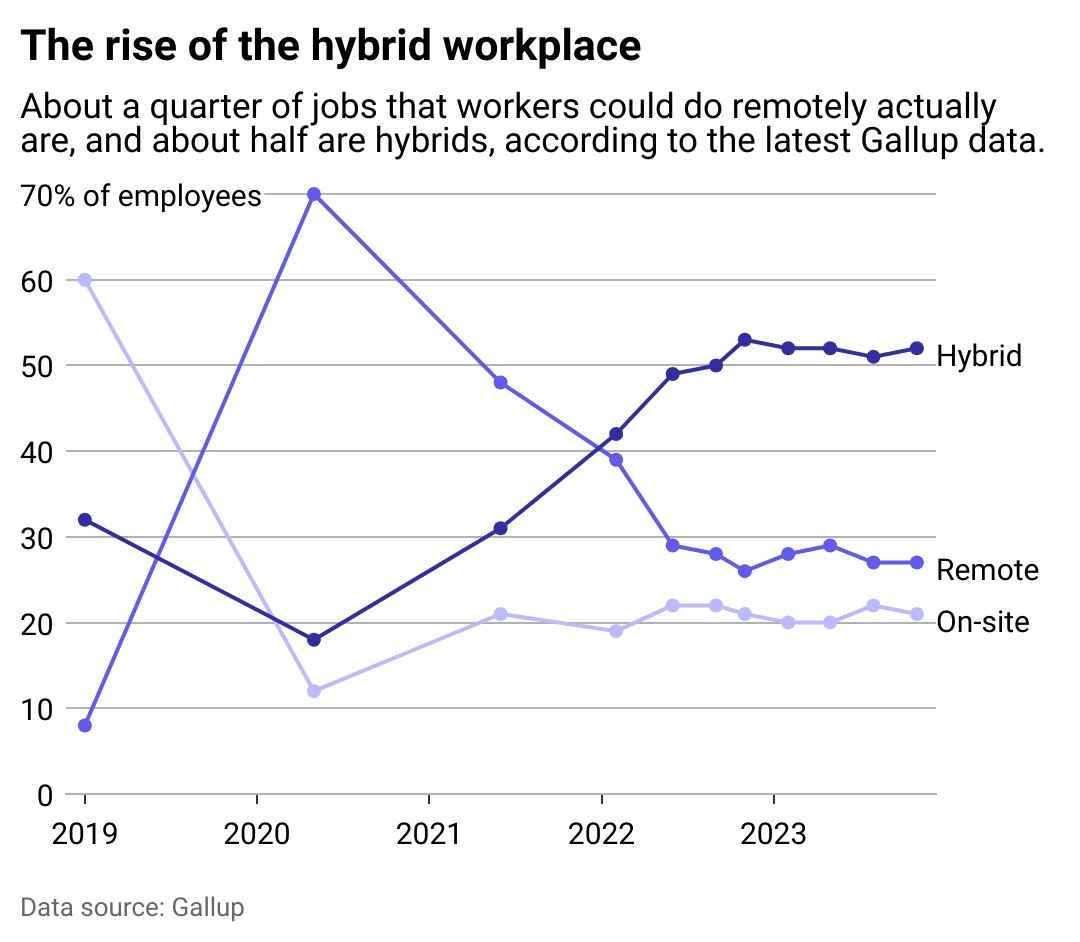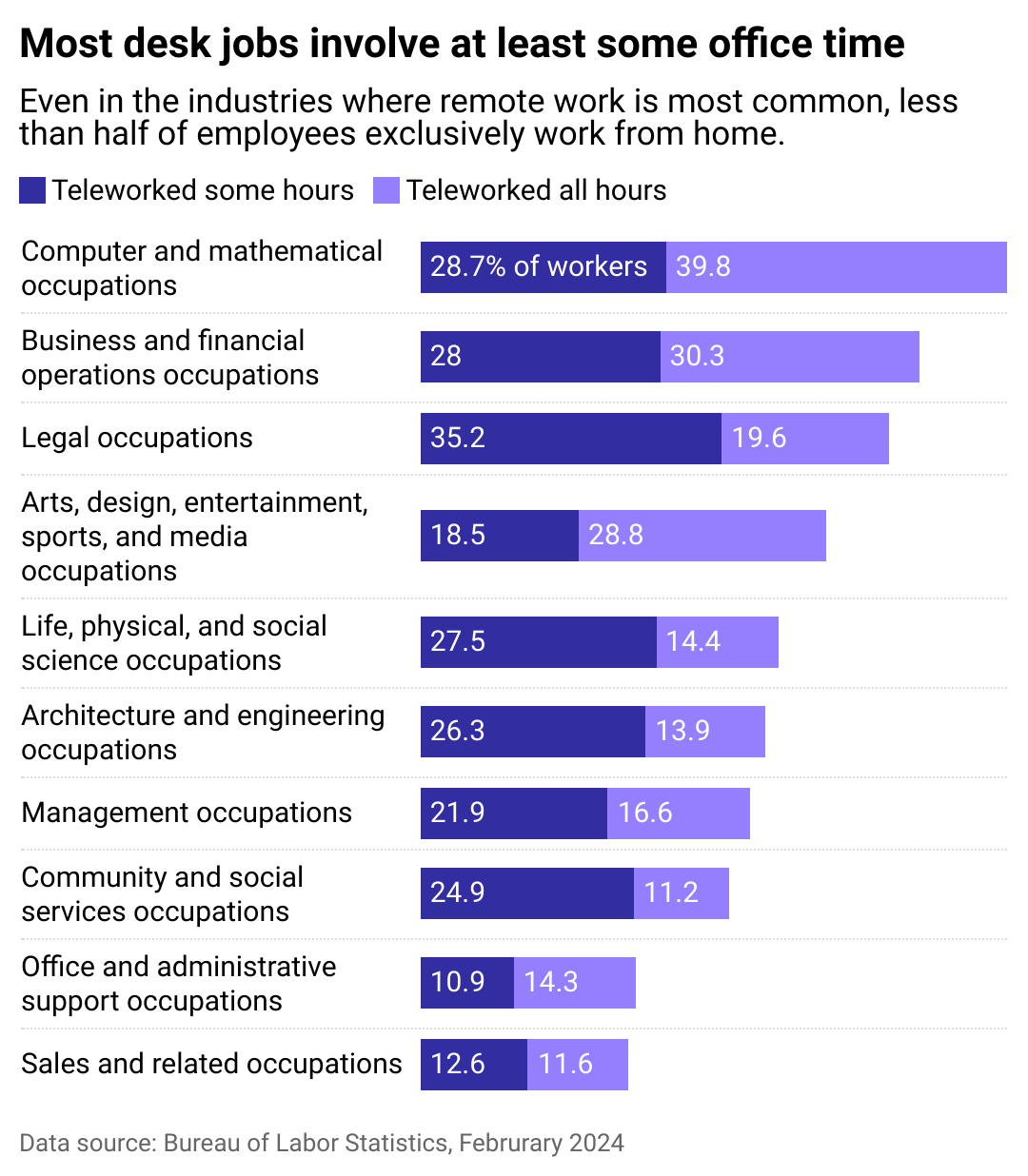
Are we past the peak of the remote work era?
This story originally appeared on JobTest.org and was produced and distributed in partnership with Stacker Studio.
Are we past peak remote work?
In 2020, doom and gloom predictions hailed the end of the office. In 2024, remote and hybrid work is here to stay, even as questions about the future of work persist.
JobTest.org explored how the prevalence of remote work has shifted since the COVID-19 pandemic using data from Gallup and the Bureau of Labor Statistics.
Workers may recall the remote work inflection point: March 11, 2020, the day the World Health Organization declared COVID-19 a pandemic. Employers worldwide shuttered their offices to prevent the spread of the virus. Overnight, lifelong office workers became telecommuters, suddenly attending those first awkward meetings online from makeshift home offices.
Employers had to quickly adapt to maintain productivity and develop a company culture around working together but apart. In a relatively short time, a sea change occurred. What seemed impossible—fully remote or hybrid work—became the norm in many industries.
But long before the masks came off and social distancing restrictions eased up, opposing camps formed in the remote work debate. In general, employees enjoyed the flexibility and balance of work-from-home life. In an August 2023 Bankrate survey, 64% of respondents preferred full-time remote work, and 68% preferred hybrid work instead of working on-site full time.
Harvard Business Review research suggests remote workers tend to feel more productive, partly because they cut out the commute that formerly factored into their work hours. However, managers are more likely to report that the loss in productivity was not worth the flexibility.
Stanford researchers found that productivity was 10% lower for fully remote workers, partly due to remote communication hassles, the lack of informal mentoring opportunities, skill development, and opportunities to build company culture. Some business leaders cited a loss of innovation due to distance. In an interview with CNBC, Nike CEO John Donahoe noted that fully remote work had dampened the company's ability to create innovative new products and cost them market share.
For many workers, the flexibility of remote or hybrid work was hard to give up, and forcing workers back into the office full-time proved contentious. A March 2024 MyPerfectResume survey found that 64% of office workers felt the push to return to the office stemmed from a lack of trust to do their jobs, even though a majority also think their managers believe it will improve productivity, communication, and collaboration.
With data reflecting the benefits of remote, hybrid, and in-person schedules, the future of work may involve compromise.

Remote and hybrid jobs remain prominent
According to Gallup research, 6 in 10 employees who can work remotely prefer a hybrid work arrangement—and if they couldn't have that flexibility, they'd look for a job that offered it.
Employees admitted that working from home did make it hard to collaborate, connect, and coordinate with teammates. However, they also felt more productive and efficient. Over 3 in 4 employees felt they had a better work-life balance, and burnout was declining, two crucial factors for employee retention.

Most remote-friendly jobs
Broadly defining remote work doesn't account for the fact that it's a luxury available only to a subset of workers with white-collar office jobs that require a computer: about 20% of the workforce, according to New York Times analysis of 2023 Census data.
These workers tend to be college-educated and well-paid—over 4 in 10 workers with incomes in the 80th percentile work remotely, according to an earlier New York Times report using American Community Survey data from 2020-21.
Many workers who can work remotely are opting to do so from a different, and often more affordable, location. Austin, Texas, attracted the most remote workers during the pandemic, with 3 in 10 newcomers working remotely.
Conversely, cities like New York, San Francisco, and Los Angeles, which rank among locations with the highest cost of living in the U.S., saw an exodus of white-collar workers. In New York, for instance, about 40,000 remote workers left the metro area pre-pandemic; within the next two years, 200,000 left.
The shift to remote work is causing a reshuffling in some industries. During the pandemic, many tech workers benefited most from workplace flexibility. But as big companies like Google, Meta, and Apple struggle in the marketplace, they've returned to the familiarity of on-site work, even including attendance as part of reviews, according to Vox reporting. Meanwhile, smaller tech companies have doubled down on fully remote work options as a recruiting tool. According to a June 2023 Scoop Technologies report, 8 in 10 tech companies with less than 5,000 employees offer fully remote or hybrid work, while less than 3 in 10 of their larger counterparts do so.
Striking the right balance between remote and on-site work will look different across industries and job responsibilities. Gallup data shows that two to three days in the office is the ideal for maintaining employee engagement while avoiding burnout and maintaining retention. It turns out work, just like so much else, is about compromise.
Story editing by Alizah Salario. Copy editing by Kristen Wegrzyn.



